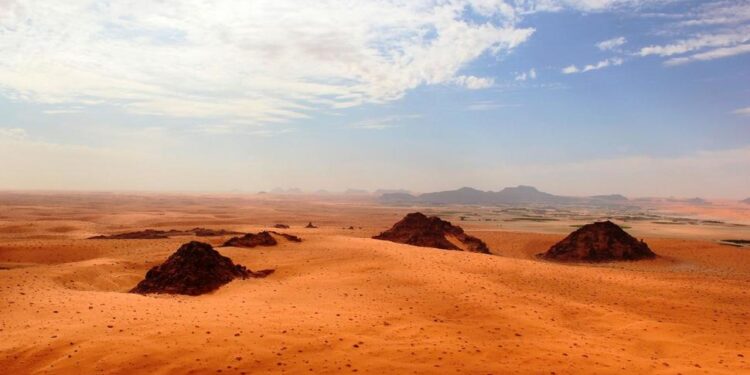Archeologist have found some prints of early humans in a prehistoric drew near ancient lake beds on Arabian Peninsula. Some stone tools and hippopotamus bones have been discovered in the region. This discovery is the part of the Palaeodeserts Project in Saudi Arabia.
Picture of the Jubbah Oasis has been shared where the signs of humans have been found from over hundreds of thousands of years during the periods of excessive rainfall.
Huw Groucutt from “Max Plank Institute of the Science of Human History” was rolling to archaeological sites in the Northern Arabian Peninsula along the sand dunes as far as he can see. He found the same sand desert area was oncelush green at a point irregularly. The green land in Arabia attracted early humans and animals like the hippopotamus. The new evidence about the region suggests that these early humans and large animals were migrating from Africa to linger at lakes.
Arabian Peninsula was only a blank spot on the map before the discovery. Formerly archaeological research has been carried put in the regions of modern-day Israel, Jordan, Lebanon, and parts of Syria, collectively the Levant region to explore early human settlements. Scientists are trying to reconstruct the story of human evolution and how they travel from Africa to the other world.
A recent study published in the journal Nature on Wednesday suggests that there is a possibility that the Arabian Peninsula has played an important role of a bridge between Africa and Eurasia.
Another Paleolithic archaeologist, Michael Petraglia, said that there was very little work on Arabia as it was not noticed as the part of the story of early human evolution and migration. He is the co-author of the research published.
Huw Groucutt said that they noticed color patterns in the sand that are prints made by ancient lakes. Sand dunes of the region are orange in color while the lake prints are white or gray tinted. Prehistoric lakes are evident in the satellite image of the archeological remains in the region. A close look of the imagery reveals the traces.
There have been massive excavations in the region for more than a decade. The research has uncovered several stone tools from multiple periods of prehistoric early human settlements. The oldest stone tool has been found from 400,000 years ago. Sediment samples of lakes and animals have been analyzed to find Peninsula-hosted animals and humans with lakes and grasslands in the distant past.
Hippos need several yards deep water to live means that the place was surrounded by rivers and lakes. There were also some remains of ostriches and antelopes. The remains show a connection with Northeast Africa as the animals were migrated from there. It shows that early humans and animals moved to this landscape when the climate changed, said by Rick Potts, paleoanthropologist.
He also added “The episodic presence and absence of populations in the Arabian Peninsula was in tune with climate oscillations.” He is not the part of the study but directs the Human Origins Program at the Smithsonian’s National Museum of Natural History.
The Palaeodeserts Research Project includes a team of scientists from Germany, Saudi Arabia, Australia and the United Kingdom.


